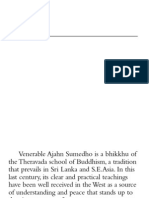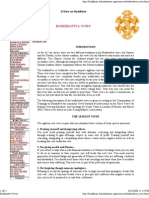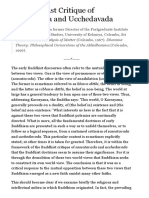Humor in Buddhism
Humor in Buddhism
Uploaded by
loltanCopyright:
Available Formats
Humor in Buddhism
Humor in Buddhism
Uploaded by
loltanOriginal Description:
Original Title
Copyright
Available Formats
Share this document
Did you find this document useful?
Is this content inappropriate?
Copyright:
Available Formats
Humor in Buddhism
Humor in Buddhism
Uploaded by
loltanCopyright:
Available Formats
The psychology of the abhidhamma recognizes several types and intensities of smiles and laughter the gentle smile
e (sita), the beaming smile where the corners of the mouth turn up and the teeth can be seen (hasita), laughter that makes an audible sound (vihasita), laughter that causes the head, shoulders and arms to tremble (upahasita), laughing until tears come to the eyes (apahasita), and roaring with laughter (atihasita). Nonetheless, the Buddha seems to have approved of humour that would raise a smile or lighten the mood, because the Tipiaka contains many examples of his urbane, subtle humour. His discourses are full of puns (silesa), a pun being the use of a word that has two different meanings or two words that sound the same, for humorous effect. For example, brahmans were also known as reciters (ajjhyaka) because they chanted the Vedas. The Buddha joked that they were really called this because they couldnt meditate (ajhyaka, D.III,94). Another way of evoking humor is by juxtaposing two connected but incongruous things, something the Buddha often did in his similes. Having good intentions but wrong practice, he said, will no more leads to Nirva than pulling a cows horn will give milk (M.III,141). He said that a fool does not benefit from his association with a wise person any more than a spoon tastes the soup (Dhp.64). Occasionally the Buddha used parody (parihpajja) to critique certain persons or ideas, particularly the pretensions of the brahmans. Once, an arrogant young brahman insisted to him that brahmans are superior to other castes because they are born from the mouth of Brahma, an idea found in the Vedas. The Buddha quipped, But surely brahmans are born from their mothers wombs like everyone else. (M.II,148). In the Dgha Nikya he gently parodied the idea of a supreme god in a way that can still raise a chuckle in the modern reader (D.I,17-18; 220-222). The art of humor has a rich tradition in the history of Buddhism. The humor that I am talking about is not malicious humor, such as insults to a fellow human being, laughter at the misfortune of another person. This kind of mean humor is for the purpose of aggrandizing oneself. It sets up the role of me being bigger and better than the other. This is not Buddhist humor. The art of humor practiced by Buddhism is seeing the subtle delight in everything. It is having a feeling of lightness about oneself. The Buddhist does not take himself seriously for the core reason that he does not feel life to be serious. He sees life as a game and is always willing to play. The seriousness that can be found in the United States for example is a seriousness that is manifested out of the ego. The conditioned ego that is so incredibly reactive to life and is always in a panic to get security knows nothing about the art of humor. If a person does not experience themselves as an image that always needs to be advanced and protected and manages their lives to make sure that they do not make fools of themselves and then jumps on an opportunity to call someone else a fool than this person is of the Buddhist spirit. The practicing Buddhist always smiles because he is happy. Humor and happiness go together; they are mutual. If you have one you will have the other. Happiness is a feeling and one cannot enter into this uplifted state of being by thinking about life as something serious that must always be put under control. Let things come as they may.
Comic Reversals and Frustration with Reason One of the main functions of humor in Zen is in trying to allow one to understand the absurdity in attempting to classify reality into categories. Thus, the boundaries formed between logical issues are broken down, revealing the frustration that Zen has with logic and reasoning.
An example of this can be seen in a Zen anecdote about a Zen master who lay dying. His monks are all gathered around his deathbed, and the senior monk leans over and asks the master for any final words of wisdom for his monks. The old master weakly says, "Tell them Truth is like a river." The senior monk relays this message on to the other monks. The youngest monk in the group is confused, and asks, "What does he mean that Truth is like a river?" The senior monk relays this question to the master, and the master replies, "O.K., Truth is not like a river." We see here a serious message wrapped up in a humorous package. The absurdity of classifying things into little boxes is revealed here: Truth is and is not like a river; it transcends classification. We can see this same sort of frustration with reason in numerous kans. Hakuin's "What is the sound of one hand clapping?" and Joshu's "Does a dog have Buddha-nature?" are all questions that cannot seriously be answered through logic; Zen humor reveals the absurdity in this. We can also see this absurdity in Zen art, with paintings of the Buddha as a naked little boy passing gas, or of a bullfrog sitting, as if performing zazen (Zen meditation), with a smirk on his face. The calligraphy on this sketch of the bullfrog by Sengai reads "If by sitting in mediation, one becomes Buddha...", leading the reader to associate this frog as being a Buddha in itself. Through this rather comic artwork, one sees the Buddhist doctrine of all animals having Buddha-nature. Humor delivers something that one does not expect -- the comic surprise, so to speak. Zen humor relies on this comic surprise not just to be funny, but also to allow the reader to experience certain truths. The humor helps break down dualities between the sacred and the profane, the beautiful and the ugly, the spiritual and the temporal. For example, one story tells of how a monk asks Ummon, "What is Buddha?" and Ummon answers, "Dried dung." Conrad Hyers remarked that in Zen, we see a "spiritual democratisation of things", meaning that all great things are humbled, and all 'lowly' things are elevated onto a level playing field. An emphasis in Zen is on the comic reversal, in which opposite terms are switched. For example, Sozan was once remarked to have said that the most prized thing in the world is a "dead cat" because "no one thinks of its value." In this comic reversal, the world has been turned upside down, collapsing all relativity. Thus, Zen humor helps one realize the futility and the uselessness in the classification and judgment of the world. In Opposites is Unity Another function of Zen humor plays a similar role of the previously discussed function: it reveals how two things, thought to be opposite, are actually the same. The breaking down of boundaries thus reveals how one should not discriminate against, but move towards a doctrine of unification and nonduality. One Zen story tells us about Zenkai, the son of a samurai, who becomes the retainer of a high official. He falls in love with the official's wife, and his adultery is discovered. In self defense, Zenkai kills the official and runs away with the wife. They both become thieves, and eventually Zenkai becomes disgusted with the woman, and leaves her. Wanting to make up for his past, Zenkai decides to dig a tunnel through a mountain where many people die while trying to pass over it. After working for thirty years on this monumental tunnel, alone, the son of the slain official finds Zenkai and wants to kill him for revenge. Zenkai tells the son that he will give up his life, but only after the tunnel has been completed. So the son waits and waits for several months, as Zenkai continues digging. The son eventually grows bored of waiting and decides to help Zenkai dig, and he comes
to admire Zenkai's perseverance and strong character. When the tunnel was finally completed, Zenkai offers his life to the son, but the son replies teary-eyed, "How can I cut off my own teacher's head?" Here we see two opposites becoming one: the enemy becomes the student. This sort of breaking of boundaries is a significant part of Zen humor. Although this story may not produce a laugh, there definitely are some comedic elements at work with such a grand reversal. Another story tells of a Chinese monk who wore a Buddhist robe, a Confucian hat, and Taoist sandals. This monk, by breaking out of religious stereotypes, reveals one of the main goals of Zen humor: to find a higher unity. Zen emphasizes the comic impulse, as opposed to the tragic, which aims to separate things out from each other, dividing the world into opposites. In Greek tragedies, protagonists and antagonists are pitted against each other, dueling for their own beliefs, unable to see the compromise of the beauty and rightness of the other side. The opposite of this is in Greek comedy, whereby two competing sides finally resolve their conflicts within some sort of absurd way (as in Aristophanes' Lysistrata, where two city states are fighting, but the war ends when the soldiers of both cities abandoning the war to unite with their loved ones in bed). The Zen vision of life, when compared between the tragic and the comic, can be seen as being comic (at least by a Western standpoint!). We see in Zen a harmony of the opposites, a unification of the yin and yang. Humor & Enlightenment A significant nonfunctional aspect of Zen humor is that after it has collapsed categories and united opposites, it helps release tension. Thus, it can be seen as an expression of liberation, and is analogous to enlightenment. Just like how one suddenly gets a joke, even if it is days later, in the Rinzai school, the attainment of enlightenment is sudden. (Note: In Dgen's St school, enlightenment is much more of a gradual process through zazen, and so much of what will be discussed in this section is not applicable to St Zen. However, in St Zen, there are sometimes certain events that can lead one closer to the final goal of enlightenment.). One story tells of a Chinese monk named Shui-lao, whose master kicks him in the chest, resulting in enlightenment (satori). The monk then says, "Ever since the master kicked me in the chest I have been unable to stop laughing." In his enlightenment, Shuilao expresses his feelings of freedom through laughter. Through laughter, Shui-lao is free, allowing his emotions and spontaneity let loose. In this sense, the original problem discussed about Buddha's laughter can be attributed to his higher understanding and liberation of the spirit - he is thus physically demonstrating his enlightenment. Thus, although Bharata's schema of laughter has been inverted in Zen, laughter has been elevated to have a new important meaning and is no longer seen as vulgar. Another story tells of how one of Buddha's disciples reveals his enlightenment through a 'wordless smile.' This smile was passed along until the Bodhidharma brought it to China, where the smile was transformed into thundering laughter. In the real world, we see how one can spontaneously trigger laughter, and this reflects the Zen tradition of how the realization of enlightenment is also spontaneous. Conrad Hyers, in his Zen and the Comic Spirit, writes that there is "often a kind of comic midwidfery in the Socratic sense of a technique for precipiating (or provoking) an inner realization of the truth." Humor, as shown before, is a vehicle for understanding the world, and helps one reach
enlightenment and remove one's attachment from the world. Thus, in Zen art, we have proof of all of this with masters and monks drawn with big bellies and gaping mouths, bursting with laughter.
You might also like
- Glossary of Terms in Wuxia, Xianxia & Xuanhuan NovelsDocument48 pagesGlossary of Terms in Wuxia, Xianxia & Xuanhuan NovelsSueChen Tan100% (5)
- Euphonic Sounds22 PDFDocument3 pagesEuphonic Sounds22 PDFAngie0% (1)
- The Concept of Flow - Jeanne Nakamura & Mihaly CsikszentmihalyiDocument17 pagesThe Concept of Flow - Jeanne Nakamura & Mihaly CsikszentmihalyiNathan HoldenNo ratings yet
- Chik She Kun Drol ProgrammeDocument2 pagesChik She Kun Drol ProgrammeloltanNo ratings yet
- The Art of Nothingness - Dada Taoism and ZenDocument59 pagesThe Art of Nothingness - Dada Taoism and ZenDenis JoelsonsNo ratings yet
- Phenomenology of LightDocument2 pagesPhenomenology of LightRudy BauerNo ratings yet
- Supertramp - Logical Song PDFDocument3 pagesSupertramp - Logical Song PDFIdsvandenMeijdenbergNo ratings yet
- Unit 12 Improvising MusicDocument10 pagesUnit 12 Improvising MusiclupitaArchieNo ratings yet
- Lyric Poem AnalysisDocument1 pageLyric Poem AnalysisRismalina AyundaNo ratings yet
- Trans Voice 101 GuideDocument40 pagesTrans Voice 101 GuideDanny PeckNo ratings yet
- Voice ProductionDocument201 pagesVoice ProductionMariella VitorouNo ratings yet
- Patz Last+CyclistDocument65 pagesPatz Last+CyclistkNo ratings yet
- Children of Sanchez: Chuck MangioneDocument1 pageChildren of Sanchez: Chuck MangioneJesús ManuelNo ratings yet
- EW Hollywood Choirs User ManualDocument86 pagesEW Hollywood Choirs User ManualAlfredo A. Elacion Jr.No ratings yet
- The Seven Deadly SinsDocument23 pagesThe Seven Deadly SinsAzraeel07100% (1)
- WatchmenDocument34 pagesWatchmenapsaxena24No ratings yet
- AA 041 GaudeamusDocument8 pagesAA 041 GaudeamusAngel MartinezNo ratings yet
- Naming ChordsDocument4 pagesNaming Chordsvhones8No ratings yet
- Voice Types and The Folds (Cords) ThemselvesDocument5 pagesVoice Types and The Folds (Cords) Themselvesmihirpatil123456789No ratings yet
- ONE U2 (Lyrics)Document2 pagesONE U2 (Lyrics)QuilletNo ratings yet
- Sumerrian PoemsDocument8 pagesSumerrian PoemsRigoberto CuellarNo ratings yet
- Mindfulness-Based Therapy: A Tool For Spiritual Growth?: ResearchDocument3 pagesMindfulness-Based Therapy: A Tool For Spiritual Growth?: ResearchFrontiers100% (1)
- Audition Info Rep. Choir v2023Document6 pagesAudition Info Rep. Choir v2023vallediosNo ratings yet
- The Psychology of Music Making in An Africa Society The ShonaDocument7 pagesThe Psychology of Music Making in An Africa Society The ShonaMurilo Gaspar MendesNo ratings yet
- Mutual Lucid DreamingDocument4 pagesMutual Lucid DreamingGeorgia StellinNo ratings yet
- Daniil Kharms - Mini-StoriesDocument24 pagesDaniil Kharms - Mini-StoriesAndrijana KrcmarNo ratings yet
- How To Write Songs On Keyboards A Complete Course To Help You Write Better Songs (Rikky Rooksby)Document420 pagesHow To Write Songs On Keyboards A Complete Course To Help You Write Better Songs (Rikky Rooksby)rstanion100% (1)
- Chords ChartDocument1 pageChords ChartJavier VelezNo ratings yet
- University Press of Mississippi Fall-Winter Books For 2019-2020Document48 pagesUniversity Press of Mississippi Fall-Winter Books For 2019-2020syates8279No ratings yet
- Symmetry As A Compositional Determinant in MusicDocument4 pagesSymmetry As A Compositional Determinant in MusicsertimoneNo ratings yet
- Genres in Improvisational Theater: Redefining Short Form vs. Long FormDocument4 pagesGenres in Improvisational Theater: Redefining Short Form vs. Long FormNicholas WenNo ratings yet
- Nine Exercises For Overtone SingingDocument3 pagesNine Exercises For Overtone SingingFernando J. LópezNo ratings yet
- 4-Part Writing (Básico)Document15 pages4-Part Writing (Básico)Silva100% (1)
- The Miracle of Consciousness, by Christian Wertenbaker - Parabola EssayDocument10 pagesThe Miracle of Consciousness, by Christian Wertenbaker - Parabola Essayols3dNo ratings yet
- A Playwriting Technique To Engage On A Shared Reflective Enquiry PDFDocument10 pagesA Playwriting Technique To Engage On A Shared Reflective Enquiry PDFEduardo orozco oteroNo ratings yet
- READING 13 Helen Bonny's Foundational Theories of Guided Imagery and Music (GIM)Document16 pagesREADING 13 Helen Bonny's Foundational Theories of Guided Imagery and Music (GIM)spala72No ratings yet
- What Would You Do If...Document1 pageWhat Would You Do If...bestatemanNo ratings yet
- Popular Song Forms DefinedDocument6 pagesPopular Song Forms DefinedMarrin Marques100% (1)
- Neo SoulDocument9 pagesNeo Soulpopslilly410% (1)
- How To Have A Good Stage PresenceDocument15 pagesHow To Have A Good Stage PresenceJ9 Yu100% (1)
- Vocal Basics (Coaching Clinic)Document11 pagesVocal Basics (Coaching Clinic)Ariqoh Amjady AnisNo ratings yet
- Stock World Sound MattersDocument172 pagesStock World Sound MattersGavin LeeNo ratings yet
- The Way It IsDocument166 pagesThe Way It IsJustin Senryu WilliamsNo ratings yet
- A Buddhist Manual of PsychologicalDocument500 pagesA Buddhist Manual of PsychologicalHelioNo ratings yet
- Grade Six Music Theory - The Rules of HarmonyDocument7 pagesGrade Six Music Theory - The Rules of HarmonyZhiyong HuangNo ratings yet
- How To HARMONIZE With Multiple SingersDocument13 pagesHow To HARMONIZE With Multiple SingersJohn Kenneth IsananNo ratings yet
- Composing Fro ChoirsDocument19 pagesComposing Fro ChoirsAleksandra Popovska100% (2)
- Symphonic Choirs ManualDocument157 pagesSymphonic Choirs ManualnachobellidoNo ratings yet
- Poems by Varun Rustagi: A Game of BasketballDocument12 pagesPoems by Varun Rustagi: A Game of BasketballVersha RustagiNo ratings yet
- Chord TheoryDocument1 pageChord TheoryHàn Dương100% (1)
- To Sing or Not To SingDocument26 pagesTo Sing or Not To SingSam Marie GadboisNo ratings yet
- Otherworlds 9781908995148 CompressDocument299 pagesOtherworlds 9781908995148 CompressGiri HaranNo ratings yet
- Abhidhamma in Daily LifeDocument188 pagesAbhidhamma in Daily LifeAlexandros PefanisNo ratings yet
- History of RapDocument7 pagesHistory of Rapmattia.tomarelliNo ratings yet
- Bachata Baisics and Lady's TurnsDocument13 pagesBachata Baisics and Lady's TurnsAnonymous Nano 56.No ratings yet
- Carl Miguel - Chapter 2 ReflectionDocument5 pagesCarl Miguel - Chapter 2 ReflectionCarl Joshua MiguelNo ratings yet
- Saigyo - Sorrow and BlossomsDocument5 pagesSaigyo - Sorrow and BlossomsPragyabg100% (1)
- She Who Laughs Loudest - A Meditation On Zen HumorDocument11 pagesShe Who Laughs Loudest - A Meditation On Zen Humork cNo ratings yet
- "Every Day Is A Fine Day" Calligraphy by Roshi Keido FukushimaDocument10 pages"Every Day Is A Fine Day" Calligraphy by Roshi Keido FukushimarhvenkatNo ratings yet
- Certain Striking Similarities To The Tao Te Ching and Zhuangzi Are Noticeable in This Week's ReadingsDocument4 pagesCertain Striking Similarities To The Tao Te Ching and Zhuangzi Are Noticeable in This Week's ReadingsJack PattersonNo ratings yet
- Critically Comment On The Song of Defenselessness of The Gods and Good Men' in Bertolt Brecht's Play, The Good Woman of Setzuan.Document7 pagesCritically Comment On The Song of Defenselessness of The Gods and Good Men' in Bertolt Brecht's Play, The Good Woman of Setzuan.Editorial Board100% (1)
- Pe Har and The Small BoxDocument2 pagesPe Har and The Small Boxloltan100% (1)
- Mealtime Recitations: Recollecting The Virtues of The Three JewelsDocument2 pagesMealtime Recitations: Recollecting The Virtues of The Three JewelsloltanNo ratings yet
- Sa Yukta Āgama: 801. Ānāpānasm Ti DharmasDocument1 pageSa Yukta Āgama: 801. Ānāpānasm Ti DharmasZacGoNo ratings yet
- The Unifying of Rdzogs Pa Chen Po and CHDocument12 pagesThe Unifying of Rdzogs Pa Chen Po and CHloltanNo ratings yet
- Samsara Is StrifeDocument1 pageSamsara Is StrifeloltanNo ratings yet
- Pali ChantingDocument205 pagesPali ChantingbudhistsluvcopyrightNo ratings yet
- Catu Pari at SūtraDocument1 pageCatu Pari at SūtraloltanNo ratings yet
- IntroductionDocument4 pagesIntroductionloltanNo ratings yet
- Molqa (13) : 334 (14) Homage To The Supreme God (Maheivaranamaskaral,)Document2 pagesMolqa (13) : 334 (14) Homage To The Supreme God (Maheivaranamaskaral,)loltanNo ratings yet
- Chinese SatiDocument9 pagesChinese SatiloltanNo ratings yet
- TOZAN Verses5Document1 pageTOZAN Verses5loltanNo ratings yet
- MN (Pali) MA (Chinese) EA (Chinese) : SuttaDocument1 pageMN (Pali) MA (Chinese) EA (Chinese) : SuttaloltanNo ratings yet
- Chinese SatiDocument9 pagesChinese SatiloltanNo ratings yet
- Chinese Dharmachakra SutraDocument4 pagesChinese Dharmachakra SutraloltanNo ratings yet
- Meaning of NAMO AMITUOFO (Namo Amitabha) ChantDocument9 pagesMeaning of NAMO AMITUOFO (Namo Amitabha) ChantKrishna kumarNo ratings yet
- 35-Buddha-Practice Explanation Tsony 1.00Document130 pages35-Buddha-Practice Explanation Tsony 1.00JimNo ratings yet
- U AggaDocument10 pagesU AggaZaw zawNo ratings yet
- Confession PracticeDocument6 pagesConfession PracticeJustin ChoiNo ratings yet
- Yashodhara TheriDocument7 pagesYashodhara TheripereradgNo ratings yet
- Jamyang Shepa Ngawang Tsondru Root Verses On Indian PhilosophiesDocument33 pagesJamyang Shepa Ngawang Tsondru Root Verses On Indian PhilosophiesBLhundrupNo ratings yet
- ETHICS Module 9 and 10Document10 pagesETHICS Module 9 and 10Samuel Allen L. GelacioNo ratings yet
- Xin Jing (Heart Sutra) Revisited (Archive) - Shaolin Wahnam Institute Virtual Kwoon and Discussion ForumDocument3 pagesXin Jing (Heart Sutra) Revisited (Archive) - Shaolin Wahnam Institute Virtual Kwoon and Discussion ForumHugo GonzalezNo ratings yet
- Bodhisattva VowsDocument11 pagesBodhisattva Vowsbuddhagyrl100% (3)
- History NotesDocument92 pagesHistory Noteschandu6898chanduNo ratings yet
- Ajivika School of Indian Philosophy - UPSCDocument2 pagesAjivika School of Indian Philosophy - UPSCjeethorizonNo ratings yet
- Satipatthana SuttaDocument5 pagesSatipatthana SuttaDoru-Mihai MunteanNo ratings yet
- Introductory.: "Gently To Hear, Kindly To Judge." SDocument31 pagesIntroductory.: "Gently To Hear, Kindly To Judge." SDan CirannyNo ratings yet
- Focus On Chod - TheMirror119Document28 pagesFocus On Chod - TheMirror119YDYD1234100% (1)
- Melody Dharma: His Holiness The Sakya TrizinDocument72 pagesMelody Dharma: His Holiness The Sakya TrizinDorje Brtsegs100% (1)
- Tilopa's Song of MahamudraDocument4 pagesTilopa's Song of MahamudraSachin Vijan100% (2)
- Dhammavuddho Thera Five IllusionistsDocument51 pagesDhammavuddho Thera Five Illusionistsdkokhui9507No ratings yet
- Female Slaves in Early IndiaDocument109 pagesFemale Slaves in Early Indiasverma6453832No ratings yet
- Drops of Nectar (Khenpo Kunpal's Commentary On Shantideva's Entering The Conduct of The Bodhisattvas)Document290 pagesDrops of Nectar (Khenpo Kunpal's Commentary On Shantideva's Entering The Conduct of The Bodhisattvas)Dimitrije CekicNo ratings yet
- Instant download The Path to Awakening A Commentary on Ja Chekawa Yeshe Dorje s Seven Points of Mind Training First Edition Shamar Rinpoche & Lara Braitstein pdf all chapterDocument55 pagesInstant download The Path to Awakening A Commentary on Ja Chekawa Yeshe Dorje s Seven Points of Mind Training First Edition Shamar Rinpoche & Lara Braitstein pdf all chapterliciomikayeNo ratings yet
- The Buddhist Critique of Sassatavada and UcchedavadaDocument22 pagesThe Buddhist Critique of Sassatavada and Ucchedavadaar15t0tleNo ratings yet
- TEN WORLDS Nicheren Daishonin Bhuddis.Document39 pagesTEN WORLDS Nicheren Daishonin Bhuddis.Maitrayee jadhavNo ratings yet
- Master Cheng Yen's Jing Si AphorismsDocument1 pageMaster Cheng Yen's Jing Si AphorismsTima Singapore100% (1)
- Anumana SuttaDocument3 pagesAnumana SuttacoolcolomboNo ratings yet
- 2 The Light of Asia - Ancient Buddhist Texts - PDF RoomDocument228 pages2 The Light of Asia - Ancient Buddhist Texts - PDF Room1 1100% (1)
- Winter Never Fails To Turn Into SpringDocument4 pagesWinter Never Fails To Turn Into Springmanash20No ratings yet
- A Arte JaponesaDocument366 pagesA Arte JaponesaAlex CardosoNo ratings yet
- Menla Long Namcho Final 8x11cDocument28 pagesMenla Long Namcho Final 8x11cTulku Rinpoche Jamyang Wangpo100% (1)
- Avalokitesvara Tantric Connections in Cambodia and Campā Between The Tenth and Thirteenth CenturiesDocument26 pagesAvalokitesvara Tantric Connections in Cambodia and Campā Between The Tenth and Thirteenth Centurieslieungoc.sbs22No ratings yet







































































































